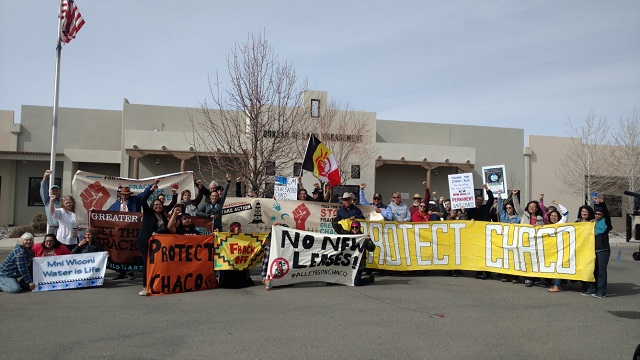Last week, something amazing happened in New Mexico. Just a week before the Bureau of Land Management (BLM) was scheduled to auction off land surrounding Chaco Culture National Historical Park to oil and gas companies, the agency called off the sale.
If you’re not familiar with Chaco, it’s as close as America gets to the pyramids of Egypt. Chaco Canyon is a UNESCO World Heritage Site, and home to the densest and most exceptional concentration of ancient pueblos in the American Southwest. The surrounding area contains thousands of archaeological sites, some of which are over 12,000 years old. Chaco Canyon is considered the sacred heart of the American Southwest and is the core of the Greater Chaco region. A thousand years ago, long before European colonization, the Ancestral Pueblos called the Greater Chaco region home. Today, the region supports Navajo, Hopi, Apache, Zuni, Ute, and Pueblo communities.
Already, more than 91% of public lands in Greater Chaco are leased for oil and gas drilling, but the administration has proposed to auction off an additional 4,434 acres for industrialized fracking, including parcels on sacred grounds and neighboring homes. Not only would drilling threaten the ancient structures there, it would also subject the people living in the region to increased pollution and threaten their health and safety.
BLM’s plan to auction off this iconic place prompted enormous backlash. Thousands of people have come together to protect this area, and an unprecedented 459 official protests were lodged against the lease sale, more than any lease sale has ever received in New Mexico. The Navajo Nation, All Pueblo Council of Governors, and 15 Navajo Chapters have all filed protests to the BLM. The decision to cancel the sale is proof of the power our communities have when we come together and stand up, even under the Trump administration and its polluter-friendly agenda.
This is a major victory, but we know the fight isn’t over. The administration’s actions over the last year make it clear that, for Donald Trump and Interior Secretary Ryan Zinke, the path to so-called “energy dominance” leads through some of America’s most cherished places and sacred tribal sites, and, to them, no amount of natural beauty or cultural history is more important than the fossil fuel industry’s profits. This was clear from their egregious (and illegal) rollback of protections for Bears Ears and Grand Staircase-Escalante national monuments, and when they laid the groundwork for drilling in the Arctic National Wildlife Refuge.
Now that the Greater Chaco land auction has been delayed, we have to keep fighting for permanent protections for this special place. That’s why community members rallied this week in front of the state offices of New Mexico Senators Tom Udall and Martin Heinrich and Congresswoman Michelle Lujan Grisham to thank them for their representation and to remind them, “It’s not over.”
They also rallied outside the BLM’s state office in Santa Fe to deliver resolutions from Navajo Nation Chapters and Pueblos, and more than 200,000 public comments pressing for a moratorium on fracking in the region, environmental and health protections, and meaningful consultation and consent from tribes.
The Navajo Nation and All Pueblo Council of Governors, National Congress of American Indians, 15 Navajo Chapter Houses, the New Mexico House Legislature, and more than 400,000 public citizens have requested a moratorium on drilling until the BLM has adequately updated their planning process to include the health, environmental, spiritual, and cultural impacts of industrialized fracking in the region.
We cannot give up the fight until BLM engages in real, meaningful consultation with the Navajo Nation and Pueblos who consider Chaco sacred and creates a new plan for the region that protects the communities and living culture of Greater Chaco.
This administration may be trying its hardest to exploit our public lands for the fossil fuel industry’s gain, but we’ll be there every step of the way to make sure corporate polluters don’t get their hands on Greater Chaco.
